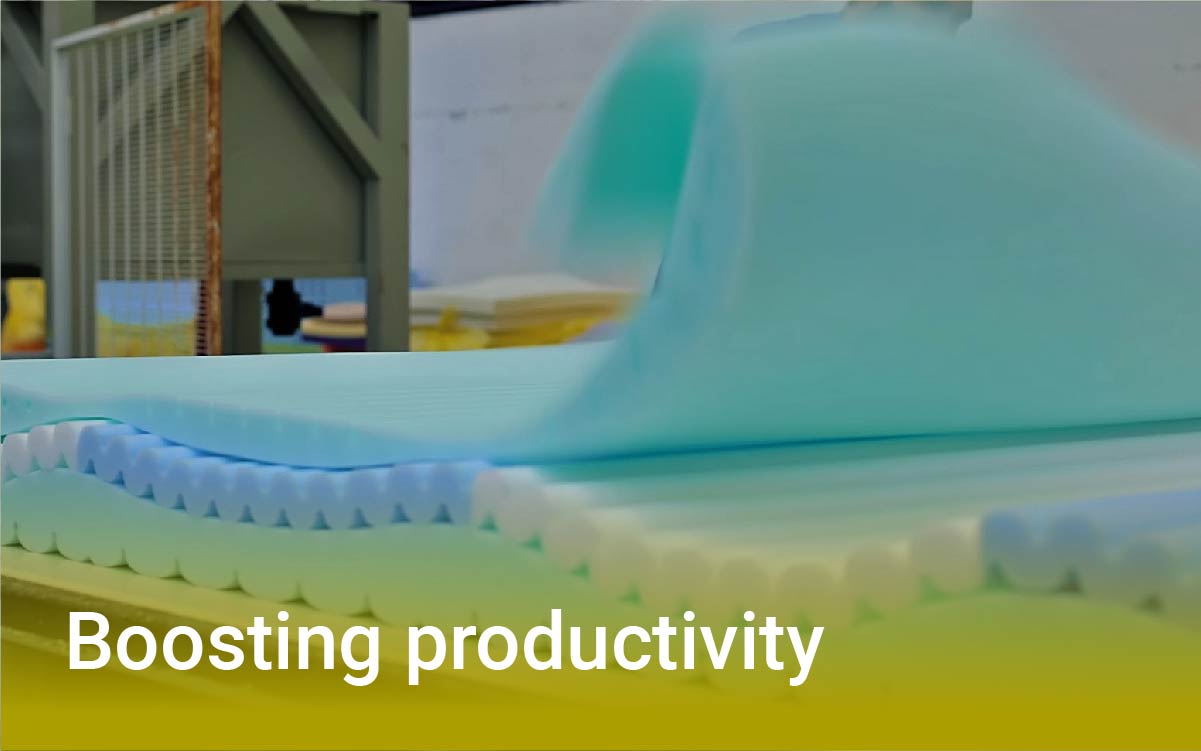The benefits of PU foam
PU foam (also PUR-foam or polyurethane foam) has become an indispensable component of many products. Depending on its exact composition, the texture of the PU foam can vary significantly. In a soft form with a high percentage of air, it is an excellent material for mattresses and upholstering. To handle the increasing pace of the production process of these products and still keep within the environmental guidelines, choosing the right materials to work with is key. This especially applies to adhesives, which need to be optimized to fit the specific requirements of the production process.
Our SIMALFA® water-based adhesives are ideally suited to PU foam bonding to itself and other materials. To optimize your production, some aspects need to be considered.
The history of gluing foam
PU foam exists in very different consistencies and is therefore used in multiple industries. In its harder form, it is used in the construction industry, for example as insulation material.In its softer form, PU foam can be used for every upholstered piece of furniture and all types of mattresses. But these softer forms vary in their consistencies too, for example in terms of density or the amount of pressure needed to compress the foam.
Depending on the end product and the user, the optimal consistency can be chosen. In general, PU foam is an affordable material and therefore recommended when large quantities are required. It is also easy to handle because it is lightweight and can easily be cut.
PU foam was invented in 1937 by coincidence.
The ingredients for the foam were mixed in the waste bin of a laboratory by accident and the chemical foaming reaction occurred. Shortly thereafter, the foam began its triumphal march around the world. But until almost the end of the 20th century, the gluing foam was associated with many disadvantages and risks. There were several adhesives on the market, such as solvent-based adhesives, natural latex adhesives, or resin adhesives.
Aside from their toxicity, solvent-based adhesives were also highly inflammable and therefore posed a double risk for the manufacturers. Latex adhesives and, later on (from the 1980’s), resin adhesives were less dangerous, but their adhesion force was also much weaker. Although solvent-based adhesives are still in use today, the most common products for foam bonding are water-based (and solvent-free) adhesives.
NEW INVENTIONS AND NEW POSSIBILITIES
As a pioneer, SIMALFA® started with the development of these safe and sustainable adhesives already in the 1980’s. In 1990, we proudly presented the first-ever high-quality water-based adhesive for foam bonding with instant tack to the world. Though SIMALFA® works entirely without any toxic solvents, its instant tack and adhesive force are even stronger than that of solvent-based formulas.
After the first patent applications, SIMALFA® quickly became market leader – to this day, the SIMALFA® line is considered the international top standard. Because of this new formula, working conditions, product quality, cost-efficiency and sustainability were significantly improved in a wide range of industries.
With SIMALFA®, PU foam can be bonded with almost every other material and is therefore extremely versatile. Due to the viscosity of our adhesives, they do not run too deep into the material. They tack instantly and hold together different materials even when they are under tension. Additionally, the amount required is significantly lower than is the case with solvent-based adhesives and even other water-based adhesives, which makes SIMALFA® the most profitable choice.
THE PROPER EQUIPMENT FOR THE BEST RESULTS
The glue can be applied to the PU foam with rollers or spray guns. For big surfaces of PU foam layers for mattresses, roller application offers many advantages. When set up properly, the double roller minimizes the amount of material used. Depending on the density of the foam, the mattresses are lightweight and easy to handle. With the right fast drying adhesive, packaging can be performed immediately after production.
For furniture, spray guns are more practical because of their flexibility. SIMALFA® offers various application systems with spray guns:
The Easy-2-Pump System includes pumps guiding the adhesive from their storage container to the workspaces. It is simple to supply several workspaces with one Easy-2-Pump System. The adhesive can be sprayed manually using a spray gun. Thanks to the pumps, the adhesive can be used further away from the container and at a different or the same horizontal height.
Alternatively, the Free Flowing System simply utilizes gravity to transfer the glue from the container to the spray gun. Without any additional pressure – just a container above the workspace and a hose routed downwards – the Free Flowing System is the easiest way to apply the glue to your PU foam. Learn more about PU foam in the upholstering industry. Our local team will be thrilled to assist you with the installation of your equipment.
Secure your personal appointment
Do you need support or advice? We love to share our know-how. Schedule your appointment now!
Read more articles
THE NEXT LEVEL for mattress manufacturing
SIMALFA® adhesives can be applied manually or automatically - both with spray guns or roller coaters. Find the right application method for your production.
Wet contact adhesives for gluing foam
Foam adhesives are often exposed to high tensile forces while the adhesive is still in its drying process. SIMALFA® wet contact adhesives are known for their strong instant tack and therefore optimal for bonding under tension.
SIMALFA®: Solutions for mattress manufacturing
Pack mattresses immediately after production. Maximize efficiency, reduce storage space requirements and increase process reliability at the same time.




